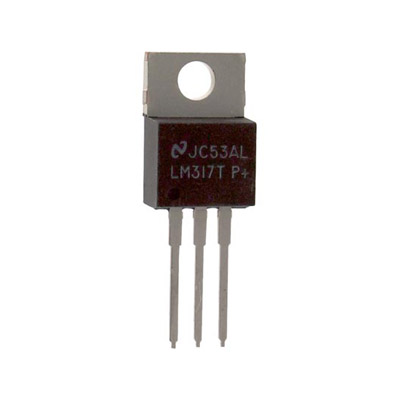Overheating a Voltage Regulator

How much current can a typical linear voltage regulator provide, like an LM317? The datasheet says 1.5 amps, which should be plenty for most hobbyist breadboard projects – or so I thought. Years ago I bought a little LM317-based power supply with breadboard-friendly headers, and it’s been great, except for an occasional tendency to randomly turn off when I’m using “too much power”. I never stopped to investigate further or measure how much current is too much, until now.
I’ve got a decent little 68008-based computer experiment working on a breadboard now (more details soon), and it runs indefinitely with the LM317 supply. But when I added an Arduino Pro Mini to the breadboard, the power supply always shut off within 30 seconds, even when none of the Arduino I/Os were connected to anything! What the heck? I measured the 68008 system’s current draw at about 250 mA, and the system plus Arduino at 280 mA. That seems low enough – far less than 1.5A.
Oh right, power dissipation! My wall-wart supplies 12V, which is regulated to 5V by the LM317. A 7 volt drop times 280 mA equals almost 2 Watts dissipated as heat. I do have a heat sink on there, but it’s just one of those little 1-square-inch folded metal pieces. How many watts can those safely dissipate? I found some info that estimated their thermal resistance at 21 degrees C per watt, so at 2 watts it should rise to 42 degrees C above ambient temperature: roughly 63 C. That pretty hot, but not insanely hot. I would have expected the LM317 to continue working at that temperature.
I removed the Arduino, and added some more random LEDs to increase the current draw to 350 mA, just to be sure there wasn’t something specific about the Arduino that was causing the problem. Then I tested out several different sizes and configurations of heat sinks. No matter what the heat sink, the LM317 shut down after about 35 seconds from starting from cold. It was bizarrely reliable, and bigger heat sinks didn’t seem to make a difference. If the LM317 was already warm, it would shut down after as little as 3-5 seconds. I just now discovered that I’ve been installing the heat sinks backwards – I had the fins facing out instead of in. But I don’t think that could explain it.
I can switch to a 9V wall-wart, or some different type of regulator, so this isn’t a major problem. But I’m curious – is this normal? I feel as though I must be overlooking something, and the LM317 shouldn’t be shutting down at these relatively low current levels.
Read 7 comments and join the conversation7 Comments so far
Leave a reply. For customer support issues, please use the Customer Support link instead of writing comments.


Did some more heat sink testing, and the best result I got was with no heat sink at all – 44 seconds. Maybe there’s something else at work here. The wall-wart is rated 12V and 1 amp. I tried substituting a different brand of wall-wart with the same specs, but got the same results.
Mystery solved. What I thought was a capacitor on the board is actually a 250 mA polyfuse. Why?! The LM317 isn’t overheating at all. I guess the fuse protects me in the case of an accidental short circuit, but only 250 mA?
Full disclosure: this is the power supply I’m using.
Maybe they thought that the polyfuse should protect the solderless breadboard, and 0.25A is as much as those things can stand? Or does the polyfuse protect the upstream power supply? Yikes — having looked at the PCB, maybe it’s there to protect the PCB tracks! Make those Vcc tracks thicker, SparkFun!
Perhaps it’d just be more suitable to wire up a generic 7805 by hand? It’s not that hard :). ANd a 7805 can handle an Amp and more dep. on the specific regulator!
Yeah, build your own is a pretty good solution. I ended up tearing out the PTC fuse and just replacing it with a piece of wire. Less safety, more current!
The first time I’ve seen a fuse on one of these kinds of breadboard PSU boards 😀
They probably put it there because at the maximum voltage difference, 250mA is all the regulator+heatsink can handle. I would double check that 21C/W number because even for a to3 lm317, it is 39C/W. And my burnt finger confirms it.